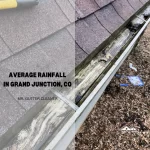Gutter guards are essential components in home maintenance, designed to prevent blockages in the gutter system by filtering out leaves, debris, and other materials.
These protective devices ensure that water flows freely away from your home, safeguarding against water damage, mold growth, and structural issues.
Diverse types available, including mesh, foam, and surface tension guards, cater to different needs and preferences.
Homeowners benefit from reduced maintenance needs and enhanced longevity of their gutter systems with these installations.
By incorporating gutter guards into their homes, individuals can mitigate risks associated with clogged gutters, such as overflows and foundation damage.
Making an informed choice involves understanding the specific advantages and compatibility of each type with one’s home architecture and climate. As an integral part of home care, gutter guards contribute to a comprehensive maintenance strategy, ensuring long-term protection and ease. Their evolving technology promises continued improvement in home maintenance solutions.
Understanding Gutter Guards: A Comprehensive Overview
Gutter guards serve as a preventative tool in home maintenance, designed to efficiently reduce the frequent need for gutter cleaning by blocking debris while allowing water to flow unobstructed. These guards are integral in prolonging the lifespan and functionality of gutter systems, thus playing a crucial role in home upkeep.
What Are Gutter Guards and Why Use Them?
Gutter guards are protective covers installed over gutters to prevent leaves, twigs, and other debris from clogging the drainage system while allowing water to pass through. Homeowners use them to avoid the laborious and often dangerous task of frequent gutter cleaning. By keeping gutters clear, they ensure effective water diversion, protecting the home’s foundation, walls, and roof from water damage.
Table Of Contents:
The History of Gutter Protection: From Past to Present
The evolution of gutter protection reflects advancements in materials and design to meet the growing demand for more effective and durable solutions. Initially simple in design, modern gutter guards now feature materials like aluminum, plastic, and stainless steel, offering various options like mesh screens, foam filters, and surface tension units. This progression underscores the industry’s response to the diverse needs of homes in different environments and weather conditions.
Types of Gutter Guards: Materials and Methods
The diversity in gutter guard types reflects the variety of homes and conditions they protect against. This section provides an overview of the materials and methods employed in different gutter guard systems, offering homeowners tailored solutions for their specific needs.
Mesh Gutter Guards: An In-Depth Look
Mesh gutter guards consist of a fine, typically metal or plastic, mesh that covers the gutter, allowing water to seep through while blocking debris. Their effectiveness lies in the fine size of the mesh, which can prevent even the smallest debris from entering the gutter. These guards are known for their durability and are a popular choice among homeowners due to their balance of efficacy and cost.
Foam and Brush Guards: How Do They Compare?
Foam and brush guards offer a different approach to gutter protection. Foam guards fit directly into the gutter, providing a porous barrier that lets water through while catching debris on top. Brush guards, with their bristle-like structure, sit in the gutter and catch debris while allowing water to pass between the bristles. Both options are easy to install and provide a cost-effective solution, though they may require more frequent cleaning than other types.
Surface Tension Guards: The Science Behind the Design
Surface tension guards, also known as helmet-style guards, work by guiding water into the gutter while allowing debris to slide off the edge. These guards use the principle of water adhesion to the guard’s surface, a method that is highly effective in heavy rainfall. They are typically more durable and long-lasting but may come at a higher cost and usually require professional installation.
How Do Gutter Guards Work?
Understanding the mechanics of gutter guards is crucial for homeowners to appreciate their value and function in home maintenance. This section elucidates the working principles of gutter guards, explaining how they effectively manage water flow and debris filtration.
The Mechanics of Gutter Protection
Gutter guards work by creating a physical barrier over gutters that allows water to pass while blocking leaves, twigs, and other debris. The effectiveness of a gutter guard depends on its design and material, which together determine how well it prevents clogging and facilitates water flow. The key to their functionality is the balance between permeability for water and impermeability for debris, ensuring that gutters remain clear and operational throughout the year.
Water Flow and Debris Filtration: The Key Principles
The core principle behind gutter guards is the separation of water from debris. Mesh, foam, and surface tension guards each utilize different methods to achieve this separation. Mesh guards use small holes to filter out debris, foam inserts absorb water while blocking solids, and surface tension units guide water into gutters while shedding debris off the edge. Understanding these principles helps homeowners choose the right type of gutter guard for their specific conditions and maintenance preferences.
Benefits of Installing Gutter Guards
The installation of gutter guards offers several long-term advantages that contribute to reducing home maintenance needs and costs. This section outlines the primary benefits homeowners can expect from integrating gutter guards into their home maintenance plan.
Preventing Clogs and Damages: Long-Term Advantages
Gutter guards significantly reduce the likelihood of gutter clogs by preventing leaves and debris from entering the gutter system. This reduction in clogs minimizes the risks of water damage to the roof, walls, and foundation of the house, potentially saving homeowners costly repairs. Furthermore, by ensuring a free flow of water away from the home, gutter guards help prevent the formation of ice dams in colder climates, which can cause extensive roof damage.
Maintenance and Cleaning: Easing Your Home Care Routine
One of the most appreciated benefits of gutter guards is the decrease in necessary gutter cleaning. With gutter guards, homeowners can avoid the dangerous and unpleasant task of climbing ladders to clean out gutters multiple times a year. This not only makes home care easier but also reduces the frequency and cost of hiring professional cleaning services. Additionally, gutter guards can extend the lifespan of gutters by preventing rust and corrosion caused by trapped debris, leading to fewer replacements and repairs.
Choosing the Right Gutter Guard for Your Home
Selecting the ideal gutter guard requires understanding the unique needs of your home and the specific benefits each type offers. This section guides homeowners through the various factors to consider when choosing the most suitable gutter guard.
Factors to Consider: Compatibility, Climate, and Costs
When selecting a gutter guard, homeowners should first consider compatibility with their existing gutter system. The size, shape, and material of the gutter play a critical role in determining which type of guard will fit and function effectively. Climate is another crucial factor; areas with heavy rainfall, snow, or abundant foliage may necessitate a more robust system. Lastly, cost considerations include not only the price of the guards themselves but also the potential for reduced maintenance and cleaning expenses. Balancing these factors helps ensure a choice that offers both effectiveness and value.
Installation Options: DIY vs. Professional Services
The installation of gutter guards can be approached as a do-it-yourself project or through professional services. DIY installations can be more cost-effective and are feasible with certain types of guards, particularly foam and brush models. However, homeowners must be confident in their ability to install them properly to avoid future issues. Professional installation, on the other hand, might be necessary for more complex systems like surface tension guards. While it involves higher upfront costs, it often leads to better performance and longevity, ensuring that the gutter guards function as intended and provide the maximum benefits.
Common Questions About Gutter Guards
Addressing common inquiries can help homeowners understand the effectiveness and maintenance requirements of gutter guards. This section aims to clarify prevalent doubts, debunk myths, and provide factual information to assist in informed decision-making.
Do Gutter Guards Really Work? Addressing Myths and Facts
Gutter guards do work by significantly reducing the amount of debris that enters the gutters, thereby decreasing the frequency of clogs and overflows. While no gutter guard can eliminate the need for occasional cleaning, they can make maintenance much more manageable and less frequent. The effectiveness varies by type and quality of the guard, as well as the specific environmental conditions of the home.
How Often Should Gutter Guards Be Replaced or Cleaned?
The longevity and maintenance frequency of gutter guards depend on the material, design, and the surrounding environment. Generally, gutter guards require less frequent cleaning than unprotected gutters. Most will need an inspection and possible cleaning once or twice a year, typically in the spring and fall. As for replacement, quality gutter guards can last several years before needing replacement. However, regular checks are recommended to ensure they are functioning correctly and to address any damage early.
Gutter Guards and Home Maintenance: A Holistic View
Gutter guards are a vital component of a comprehensive home maintenance strategy. This section underscores the importance of integrating gutter guards into the broader context of home upkeep, reflecting on their role in ensuring the longevity and health of your home.
Integrating Gutter Guards into Your Overall Home Maintenance Plan
Incorporating gutter guards into a home maintenance plan enhances the home’s protection against water damage, reduces the need for frequent gutter cleanings, and contributes to the overall health of the house structure. Effective home maintenance involves regular inspections of the roof, gutters, and downspouts, and with gutter guards in place, these inspections tend to be less laborious and less frequent. This holistic approach ensures that every part of the home’s exterior works together efficiently to provide maximum protection and durability.
Future Trends in Gutter Protection Technology
The future of gutter protection is promising, with continuous innovations aimed at increasing efficiency, durability, and ease of maintenance. Advancements in materials science are leading to more robust and long-lasting gutter guards that better resist environmental wear and tear. Technological improvements are also focusing on enhancing the design and functionality of gutter guards, making them more effective in diverse climates and conditions. Keeping an eye on these trends can help homeowners make informed decisions when upgrading or replacing their gutter guards, ensuring they benefit from the latest in home maintenance technology.


